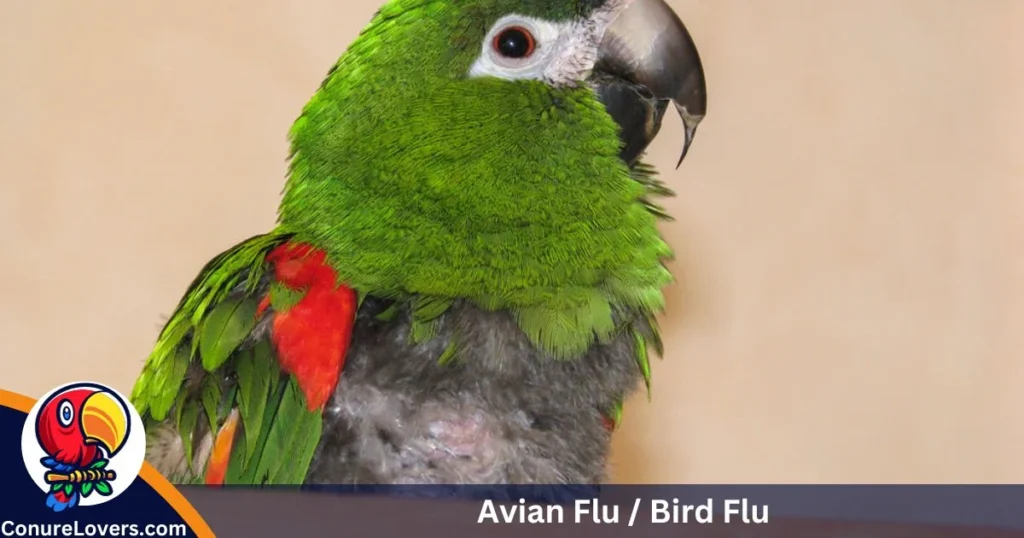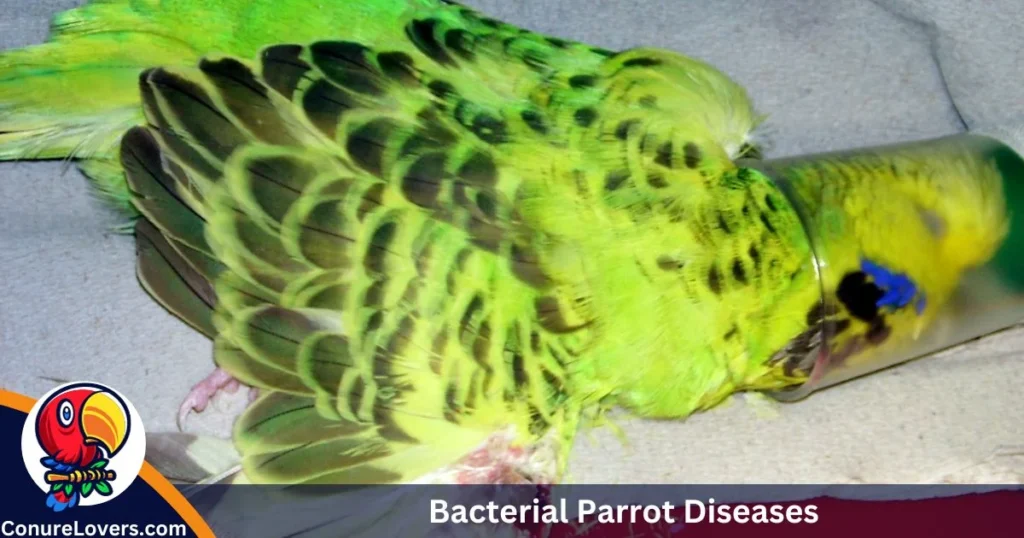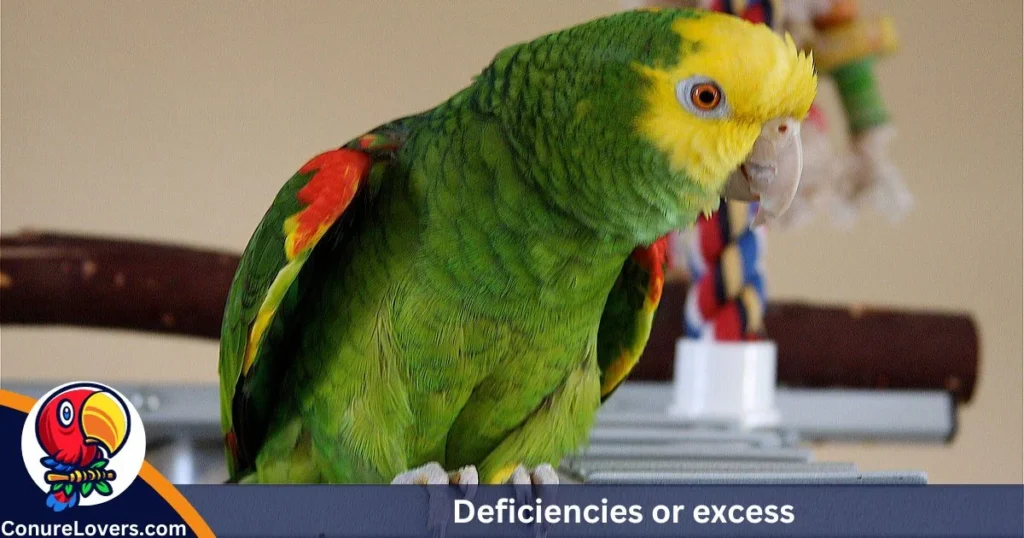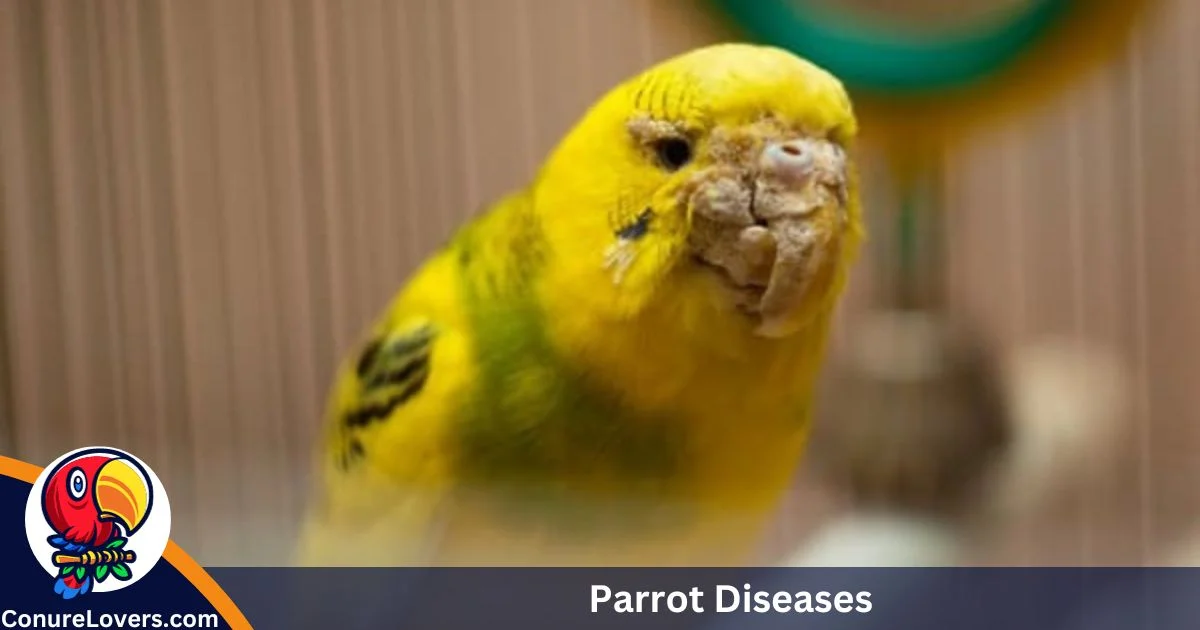Getting a bird for your home can mark the beginning of a fantastic relationship. However, it’s crucial to be well-informed about various parrot diseases and health issues that could affect your pet. This knowledge enables you to spot early signs of illness and seek prompt treatment. This article provides a summary of important parrot diseases you should be aware of.
Candidiasis is a common fungal disease in parrots, especially in birds that have weakened immune systems or are young. Poor hygiene is a common cause. The symptoms of this disease include issues like crop stasis, loss of appetite, white plaques in the mouth, weight loss, and regurgitation.
Check out the summary table in the next section, highlighting whether these diseases can be transmitted from bird to bird (horizontal transmission), bird to human (zoonotic), or hen to egg (vertical transmission)!
Wondering if your budgie is unwell or just taking a break? Sick birds may seem lethargic even during rest.
Having a parrot or any bird is a fantastic way to build a strong connection. As you communicate and bond with your parrot, you’ll discover many fascinating aspects about it. It’s an exciting and fulfilling journey.
Yet, being a bird owner isn’t a walk in the park. Remember, you’re responsible for a living being entirely reliant on you. This includes caring for their health, which sometimes involves hefty vet bills, and being aware of potential diseases they might face. Detecting illness symptoms is crucial for providing the right care to your feathered friend.
It’s also helpful to know which parrot diseases might affect humans. While the chances of catching a disease from pet birds are low, extra caution is necessary if your bird is suspected or diagnosed with a transmissible disease. Family members with weakened immune systems should avoid contact with birds carrying transmissible diseases.
Summary of Parrot Diseases and Transmissibility
| Type | Name | Horizontal (bird to bird) | Vertical (bird to egg) | Zoonotic (bird to human) |
| Viral | Proventricular Dilatation Disease (PDD) / Macaw Wasting Disease / Avian Bornavirus | Yes | Possible | No |
| Viral | Psittacine Beak and Feather Disease (PBFD) | Yes | Yes | No |
| Viral | Avian Polyomavirus | Yes | Possible | Possible |
| Viral | Avian Flu / Bird Flu | Yes | Possible | Yes |
| Fungal | Candidiasis / Candida | Yes | Yes | Possible |
| Fungal | Aspergillosis | No | No | No |
| Fungal | Avian Gastric Yeast / Megabacteriosis | Yes | Not known | Possible |
| Bacterial | Psittacosis / Chlamydophilosis / Chlamydiosis / Parrot Fever | Yes | Yes | Yes |
| Bacterial | Avian Mycobacteriosis / Avian Tuberculosis | Yes | Yes | Possible |
| Parasitic | Giardiasis | Yes | Not known | Possible |
| Parasitic | Air sac mites | Yes | Not known | Might bite humans but may not survive long on humans |
| Parasitic | Feather mites | Yes | Not known | Might bite humans but may not survive long on humans |
| Parasitic | Scaly Face Mites / Scaly Leg Mites | Yes | Not known | No |
| Parasitic | Ticks | Yes | Not known | Might bite humans but may not survive long on humans |
| Parasitic | Lice | Yes | Not known | Might bite humans but may not survive long on humans |
| Parasitic | Worms | Yes | Not known | Possible |
| Deficiencies or excess | Hypovitaminosis-A | No | No | No |
| Deficiencies or excess | Hypocalcaemia | No | No | No |
| Deficiencies or excess | Fatty tumors (including lipoma and xanthomata) | No | No | No |
| Deficiencies or excess | Fatty liver disease | No | No | No |
| Others | Stargazing/twirling | No | No | No |
| Others | Rhinoliths | No | No | No |
| Others | Seizures | No | No | No |
Viral Parrot Diseases

Proventricular Dilatation Disease (PDD) / Macaw Wasting Disease / Avian Bornavirus
Proventricular Dilatation Disease occurs when nerves affecting a bird’s stomach and gastrointestinal tract are damages. This disease is commonly found in African grey parrots, macaws, cockatoos, Amazon parrots, and conures. While it is generally link to a virus called Avian Bornavirus, the exact cause remains a mystery.
Often called Macaw Wasting Disease, it describes symptoms like regurgitation, loss of appetite, passing undigested seeds in feces, and progressive weight loss. As it targets the nervous system, birds may also show neurological symptoms such as head tremors, ataxia, weakness, and depression. Diagnosing PDD in live birds is challenging, and symptoms resemble those of other diseases.
While exposure to an infected bird may not necessarily lead to transmission, it’s advisable to isolate the infected bird. PDD is not known to affect humans, but there is a possibility of vertical transmission (from hen to eggs).
Psittacine Beak and Feather Disease (PBFD)
Psittacine beak and feather disease is a fatal illness affecting most parrots except cockatiels. Most birds affected are generally 2 years old or younger. It is causes by a virus known as Circovirus.
Symptoms include abnormal feather development, loss of feathers, absence of dander, and lesions or abnormalities in the beak. Birds affected often struggle to eat or fly properly due to poor structural development. While there is no cure, supportive care in a stress-free environment can extend a bird’s life. It is transmits from hens to eggs, but it’s not known to cause disease in humans.
Avian Polyomavirus
Polyomavirus, belonging to the same family as Papovirus, affects budgies and various parrots. The infection spreads through droppings, eggs, feathers, or crop milk of an infected bird. Fully-grown birds may resist the virus, but they can spread it to young birds who often die before showing symptoms.
While there’s no cure, supportive care is prescribes. Viral contamination is prevents through manual cleaning. There’s also a vaccine available for parrots. The avian polyomavirus is sprat vertically (parent to egg), between birds, and possibly to humans too.
Avian Flu / Bird Flu

Avian flu, or bird flu, is transmitted from birds to humans. The H5N1 strain is the most fatal. It affects humans, animals, but is deadliest for birds. The virus is naturally occurring in birds but becomes extremely contagious in domesticated birds, causing severe illness and sometimes death.
Spread through nasal secretions, saliva, and feces, symptoms include decreased food consumption, reduced egg production, sneezing, and coughing. Humans should be cautious as it is transmitters to them. The infect bird is isolated, and there’s some evidence of possible vertical transmission.
Read Also: Can Parrots Eat Mango? (Yes, Nutritional Benefits?)
Fungal Parrot Diseases
| Parrot Disease | Description |
| Candidiasis / Candida | Candidiasis is a common fungal disease in parrots, often affecting those with weakened immune systems or young birds. Poor hygiene is a significant factor in its occurrence. Symptoms include crop stasis, anorexia, white mouth plaques, weight loss, and regurgitation. Candida fungus strains primarily target the gastrointestinal system. Newborn cockatiels are most susceptible, and the infection is usually internal. It results from yeast overgrowth or oral inoculation of Candida, often through unclean utensils or parental feeding. Diagnosis involves cytology or fungal culture. Early detection is crucial, and treatment involves antifungal medications. Identifying any predisposing factors is essential for effective treatment. |
| Aspergillosis | Aspergillosis is an opportunistic fungal infection, affecting immunocompromised birds, particularly those on a seed-heavy diet. Symptoms include respiratory distress, anorexia, depression, and voice change. The infection can target various areas, from the upper respiratory tract to internal organs like kidneys and brain. Diagnosis considers bird species, imaging, and blood tests. Early detection is challenging but vital for effective treatment. Treatment is often costly and long-term. Aspergillosis is infectious but not contagious. Transmission occurs through inhalation of Aspergillus spores, potentially affecting chicks through eggshell penetration. Though fatal, medications and long-term care can help affected birds. |
| Avian Gastric Yeast / Megabacteriosis | Avian gastric yeast, caused by Macrorhabdus ornithogaster, affects the ventriculus or proventriculus in birds, commonly companion birds like parrotlets, budgerigars, lovebirds, finches, and cockatiels. Despite initial confusion as a bacterium, it’s confirmed as a fungal infection. Clinical signs include regurgitation, weight loss, undigested food passing, diarrhea, and lethargy. It mimics symptoms of proventricular dilatation disease, making diagnosis complex. Though fatal, proper care and medication can lead to recovery. Relapses are possible, especially with circovirus and polyomavirus infections. Diagnosis involves examining fresh droppings, and treatment includes antifungal medications. Avian gastric yeast is contagious among birds, but vertical transmission to eggs and human infection are not known to occur. |
Note: Fungal diseases in birds require prompt attention, and consulting a vet for accurate diagnosis and treatment is crucial.
Bacterial Parrot Diseases

| Parrot Disease | Description |
| Psittacosis / Chlamydophilosis / Chlamydiosis / Parrot Fever | Psittacosis is a common bacterial infection affecting companion birds, particularly prevalent in budgerigars, cockatiels, and small parrots. The incubation period ranges from three days to weeks, with the bacterium present in feces, ocular, and nasal discharge. While some birds may be asymptomatic carriers, symptoms include greenish diarrhea, anorexia, dyspnea, dehydration, conjunctival discharge, polyuria, conjunctival irritation, monocytosis, and biliverdinuria. Diagnosis is challenging, with PCR assay testing being the most reliable method. It can be transmitted to humans and spread from hen to egg. Isolation and medication are essential for treatment. |
| Avian Mycobacteriosis / Avian Tuberculosis | Avian mycobacteriosis affects companion, domesticated, causing lesions in the gastrointestinal tract and liver. Symptoms, often non-specific, depend on the infection’s duration, with immunocompromised birds being more susceptible. Common in Amazon parrots and grey-cheeked parakeets, it can spread between birds and to eggs. Clinical signs include depression, anorexia, diarrhea, and weight loss. Diagnosis involves biopsy, PCR assay, cytology, or histopathology, with acid-fast staining, DNA probe, culture, and biopsy being reliable methods. While research suggests low zoonotic transmission, caution is needed, especially in immunocompromised humans. Infected birds should be isolated, and treatment, lasting six months or longer, is available. |
Parasitic Parrot Conditions
| Parasitic Parrot Diseases | Description |
| Giardiasis | Giardiasis is caused by the protozoan parasite Giardia, transmitted through drinking or bathing water. Symptoms include itching, dry skin, regurgitation, and diarrhea with mucus. It affects various bird types, especially cockatiels, lovebirds, and budgies. Contaminated water sources should be avoided, and testing for giardiasis involves fecal stains, trichome, and ELISA tests. The parasite may be transmitted to humans. Treatment involves antiparasitic medication. |
| Air Sac Mites | Air sac mites invade the respiratory system of birds, causing symptoms like voice changes, wheezing, and clicking sounds during breathing. It is fatal and can spread quickly among birds, requiring immediate isolation of affected birds. Diagnosis can be challenging, and an avian vet’s intervention is crucial. Treatment options are available, and early detection is essential. |
| Feather Mites | Feather mites, also known as red mites, are blood-sucking parasites that live in feather follicles and on the skin. Symptoms include restlessness, feather destruction, and mite eggs in feathers. They can lead to anemia and pose a risk to adult birds and chicks. Treatment involves careful observation, swabs, and prompt vet intervention. |
| Scaly Face Mites / Scaly Leg Mites | Scaly face mites affect the cere and beak, while scaly leg mites cause leg swelling and flaking. Symptoms include rubbing, scratching, crusty growth on the cere, misshapen beak, and facial feather loss. Early intervention with an avian vet is essential to prevent irreversible damage. |
| Ticks | Ticks are blood-sucking mites causing anemia and potential death in birds. They are challenging to spot, often hiding beneath feathers. Ticks can easily spread between birds, other pets, and humans. Infected birds must be isolated, and the environment thoroughly sanitized. Prevention and treatment options are available. |
| Lice | Parrot lice, known as Mallophaga, are feather-eating pests. They can be uncommon in domesticated birds but may be transmitted from wild birds. Symptoms include violent scratching, feather destruction, and a moth-eaten appearance. Early detection allows for effective treatment with contact chemicals prescribed by vets. Lice may bite humans, causing rashes. |
| Worms | Ascaris roundworms infect the guts of birds, causing malnutrition, weight loss, and paralysis. Symptoms include listlessness. The disease is treatable with medication that eliminates worms. Roundworms pose a risk to humans and require immediate treatment. Regular vet check-ups and deworming are recommended for prevention. |
Deficiencies or excess

| Nutritional Deficiency Diseases in Parrots | Description |
| Hypovitaminosis-A | Hypovitaminosis-A is a deficiency of vitamin A, crucial for birds’ health. Insufficient vitamin A can lead to thickened and infected membranes in the mouth, throat, nose, and kidneys. It manifests as blocked nostrils, facial sinuses, and abscesses in the tongue. Improved feed supplemented with vitamin A is essential for treatment. While not contagious, secondary diseases may arise due to lowered immunity. |
| Hypocalcaemia | Hypocalcaemia results from inadequate calcium supplementation, impacting various bird life stages. Breeding parrots may produce no or soft-shelled eggs, and chicks may develop soft and deformed bones (rickets). Adult birds can experience weakness, muscle tremors, and seizures. Treatment involves a calcium-rich diet under veterinary guidance. It is not known to spread to humans, other birds, or eggs. |
| Fatty Tumors (Lipoma and Xanthomata) | Various tumors, especially in budgerigars, can arise due to poor nutrition. Tumors may affect internal organs or manifest externally in feathers, skin, or preen glands. Lipomata (fat accumulation) and xanthomata (cholesterol accumulation) are common benign tumors. While often non-aggressive, some tumors may be cancerous. Diagnosis and treatment involve veterinary consultation. |
| Fatty Liver Disease | Fatty liver disease is a severe condition prevalent in species like cockatoos, cockatiels, lovebirds, budgies, Quaker parrots, and Amazon parrots. Caused by large fat deposits, it impairs liver function. Symptoms include lethargy, weight loss, swollen abdomen, and behavioral changes. Early detection is crucial, and treatment includes a low-fat diet and nutritional support. Exclusive seed diets, overeating, and lack of exercise contribute to the disease. Veterinary intervention is essential for proper care. |
Final Note
Key Points for Bird Owners:
1. Bird diseases vary, each with unique symptoms. Stay vigilant for any physiological or behavioral changes in your bird.
2. Home diagnosis is challenging; note symptoms and consult a professional avian veterinarian for accurate diagnosis and treatment.
3. Avian veterinarians provide essential expertise; always seek their advice for the best results in your bird’s health.
4. In areas without avian vets, consider consulting online vets for guidance.
5. This article offers information but consult a professional avian vet for a comprehensive treatment strategy.
6. Birds are wonderful companions; ensure they receive love, attention, and proper care.
7. If you have suggestions for diseases or conditions not covered, let us know.
Note: This summary provides key takeaways for bird owners from the provided information.

It’s Ethan Richards, your Feathered Pal Expert from “Conure Lovers.” Let’s embark on a delightful adventure of conure companionship. I’ll share practical tips to ensure your feathered buddy lives a happy and healthy life.












